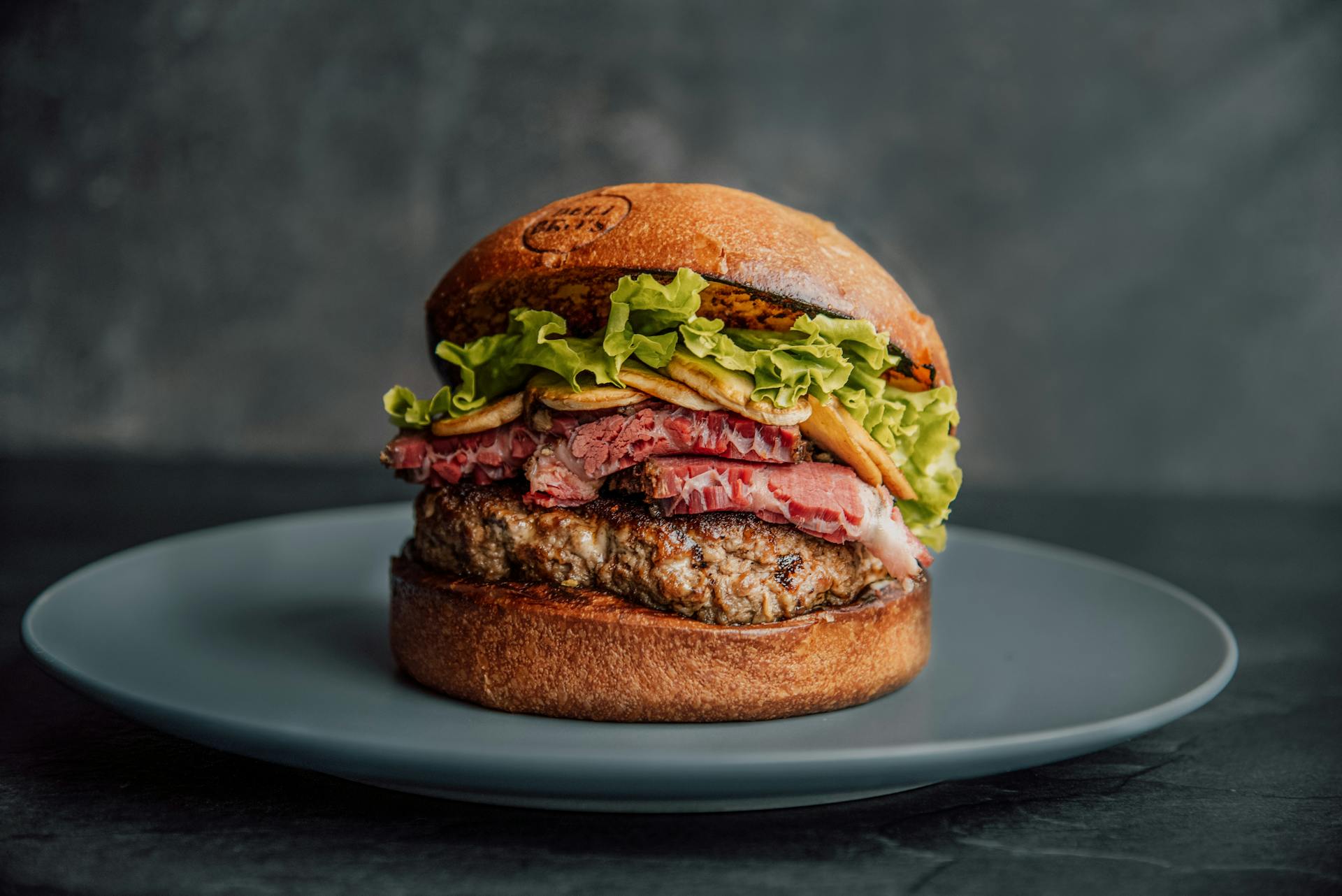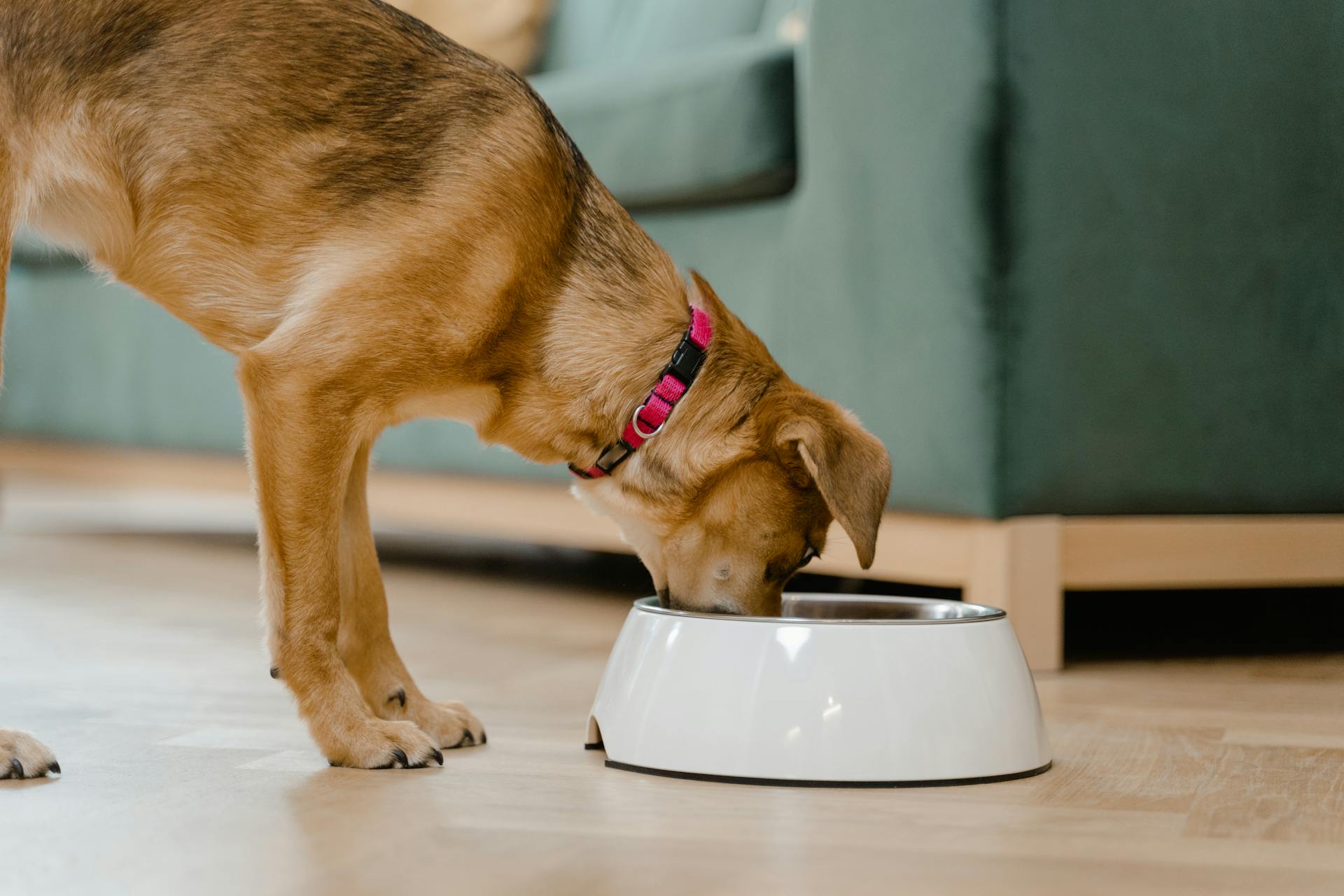
A food elimination diet for dogs is a simple yet effective way to identify and address food sensitivities or allergies in your furry friend. This diet involves removing common allergenic ingredients from your dog's food for a period of time to see if symptoms improve.
Common culprits include beef, dairy, wheat, soy, and eggs, which are often found in commercial dog foods. Removing these ingredients can help alleviate symptoms such as itching, digestive issues, and skin problems.
By following a food elimination diet, you can help your dog feel more comfortable and reduce the risk of chronic health issues. It's a great way to take control of your dog's health and well-being.
What Is It?
An elimination diet for dogs is a systematic process of removing potential allergens from their diet, replacing them with novel, hypoallergenic ingredients.
This process helps to pinpoint the specific ingredients that trigger adverse reactions in your canine companion.
The goal of an elimination diet is to identify the exact ingredients that cause problems, allowing you to make informed decisions about your dog's food.
By removing common allergens and introducing new ingredients, you can determine which foods are safe for your dog to eat and which ones to avoid.
Purpose and Benefits
The primary goal of a food elimination diet for dogs is to diagnose food allergies or sensitivities. This is because other testing methods, like those used for environmental allergies, can't accurately identify food allergies.
Symptoms of food allergies in dogs include skin issues, gastrointestinal disturbances like diarrhea and vomiting, and chronic ear infections. These symptoms can be uncomfortable and even painful for your furry friend.
By monitoring symptom resolution when problematic ingredients are omitted, an elimination diet clarifies which ingredients are causing the issues. This helps you identify the culprits and make informed decisions about your dog's diet.
For more insights, see: What Do Food Allergies Look like in Dogs
Identifying Food Allergies in Dogs
Recognising the signs of food allergies in dogs is the first step before considering an elimination diet. Typical signs include excessive itching, red skin, chronic gastrointestinal problems, and recurrent ear infections.
If your dog is experiencing these symptoms and they persist, it might suggest a food-related issue, prompting the need for an elimination diet.
Common allergens in dogs include proteins like beef, chicken, dairy, lamb, pork, fish, wheat, eggs, soy, and corn.
These foods are often removed in an elimination diet due to their high allergenic potential in many dogs.
Removing these common allergens minimises the likelihood of triggering an allergic response, making it easier to identify the specific protein your dog is allergic to.
Here are the typical foods excluded in an elimination diet:
- Beef
- Chicken
- Dairy
- Lamb
- Pork
- Fish
- Wheat
- Eggs
- Soy
- Corn
Your veterinarian can provide strict guidance on how to work an elimination diet, including recommending a completely hypoallergenic diet with a plant-based protein like soy.
How to Use for Dogs
An elimination diet for dogs is a great way to identify food sensitivities and allergies. To start, you'll need to swap your dog's usual diet with the elimination diet, and this should be their only source of food.
No treats, flavored medications, or supplements should be given unless approved as part of the diet. This is crucial for accurate results.
The observation phase typically lasts 8-12 weeks, during which time you should observe any improvement in symptoms. This is a critical period, as it allows your dog's body to reset and clear out any allergens.
To prepare the diet, choose a novel protein source like duck or fish, paired with a simple carbohydrate like sweet potato or rice. Ensure these ingredients are new to your dog to eliminate pre-existing sensitivities.
Cook all ingredients thoroughly to improve digestibility and reduce the risk of foodborne illness. Avoid using any seasonings, oils, or additives that could trigger reactions.
Here's a general guideline for the proportion and balance of the diet:
Follow veterinary guidance on the correct proportions to ensure a balanced diet.
The reintroduction phase is where you slowly add back former foods one at a time, observing for any return of symptoms. This will help you identify which foods are causing the issues.
Remember to keep a detailed food diary to note what ingredients were used and any reactions observed. This will be invaluable in identifying the culprit foods.
Primary Foods Removed
In an elimination diet for dogs, certain foods are removed due to their high allergenic potential. These foods include beef, chicken, dairy, lamb, pork, fish, wheat, eggs, soy, and corn.
Removing these common allergens minimizes the likelihood of triggering an allergic response in dogs. This is because proteins, such as those found in these foods, are frequent culprits of allergic reactions.
The following foods are typically excluded in an elimination diet:
- Beef
- Chicken
- Dairy
- Lamb
- Pork
- Fish
- Wheat
- Eggs
- Soy
- Corn
Alternatives and Considerations
Elimination diets can be highly effective, but they're not the only solution for dogs with food sensitivities. Alternative approaches include using over-the-counter hypoallergenic diets, which may contain hydrolysed proteins.
These diets break down proteins into smaller segments that are less likely to trigger an immune response, making them a good option for dogs with food-responsive diarrhoea (FRD).
Key Considerations
To successfully navigate a homemade elimination diet, it's essential to have veterinary support. This ensures your dog remains healthy and receives all necessary nutrients.
You'll need to work closely with your veterinarian to determine the best course of action for your dog's specific needs.
The duration of a homemade elimination diet is typically 8-12 weeks, after which you can gradually reintroduce other foods, one at a time, to test for allergies.
This process helps you identify which ingredients are causing issues and allows you to make informed decisions about your dog's diet.
To keep your dog's diet safe and healthy, be sure to handle and prepare all ingredients with care to prevent contamination.
Are There Alternatives?

If you're not a fan of elimination diets, don't worry, there are alternatives. Over-the-counter hypoallergenic diets can be a good option, especially for dogs with food-responsive diarrhoea (FRD), which is often recommended by vets.
These diets contain hydrolysed proteins that break down proteins into smaller segments, making it less likely for your dog to have an immune response. This can be a game-changer for dogs that struggle with traditional protein sources.
A balanced, plant-based diet can also serve as a novel food source for dogs, which can be particularly helpful if traditional protein sources are problematic. This type of diet can provide a much-needed break for dogs that are sensitive to certain ingredients.
See what others are reading: Is High Protein Dog Food Good for Dogs
Implementing
Implementing a food elimination diet for your dog requires some planning and attention to detail.
Choose a novel protein source that your dog has not previously consumed, such as rabbit or venison, and source it from a reliable supplier to ensure quality and safety.
Initially, keep the diet simple by including only one protein source and one hypoallergenic vegetable, like squash or pumpkin, to maintain fibre intake.
Supplementing with essential nutrients like omega fatty acids, vitamins, and minerals is crucial to prevent deficiencies during the elimination phase.
Monitoring your dog's symptoms closely is vital, and you should adjust the diet as necessary based on veterinary advice.
Here's a rough outline of the steps to follow:
- Choose a novel protein source.
- Include one hypoallergenic vegetable.
- Supplement with essential nutrients.
- Monitor and adjust the diet as necessary.
Remember, the goal is to keep the diet simple and effective, so avoid mixing too many ingredients initially.
Assessing and Reintroducing
After the recommended 8-12 weeks on the elimination diet, it's time to assess the results.
If there's a significant improvement in your dog's condition, it's likely that one or more of the previously excluded ingredients were the culprits.
You'll need to reintroduce potential allergens one at a time to pinpoint the specific allergen(s).
Gradually incorporate each ingredient back into your dog's diet while closely monitoring for any adverse reactions.
If a particular ingredient triggers a return of allergy symptoms, you've likely identified the culprit and should steer clear of that from now on.
You can start with a 1.5kg or 6kg Digestion Bundle, which includes All Day Buffet Complete Food & Poop Perfector Treats.
Here are some options to consider:
- 1.5kg Digestion Bundle
- 6kg Digestion Bundle
Duration of Intolerance
An intolerance typically involves digestive upset and may resolve over time by changing aspects such as your dog's diet. This means that if your dog has a food intolerance, you may not need to keep them on an elimination diet forever.
In fact, it's recommended to allow 6-8 weeks for previous allergens and intolerances to fully leave your dog's system before assessing the results of the elimination diet. This allows their body to reset and clear out any allergens.
By giving your dog's system time to recover, you can better determine which foods are causing issues and make informed decisions about their diet.
Frequently Asked Questions
How long does it take for a food allergy to leave a dog's system?
Resolution of clinical signs from a food allergy can take several weeks to months after the allergenic agent is removed from a dog's diet. This timeframe may vary depending on individual factors, such as the presence of other allergies.
What is the most common food allergy in dogs?
The most common food allergy in dogs is beef, affecting approximately 34% of dogs with food allergies. This is a crucial consideration for dog owners to ensure their pet's dietary needs are met.
Sources
- https://www.bonza.dog/2024/04/elimination-diet-for-dogs-comprehensive-guide/
- https://www.geniusvets.com/pet-care/learn/dogs/dog-nutrition/how-does-elimination-diet-work
- https://mygrubclub.com/blogs/pet-welfare/the-ultimate-guide-to-elimination-diets-for-dogs-finding-relief-for-food-allergies
- https://www.dvm360.com/view/identifying-food-allergies-veterinary-elimination-diet-trial
- https://chappellevet.ca/diagnosing-food-allergies-in-dogs-elimination-diet-trials/
Featured Images: pexels.com


